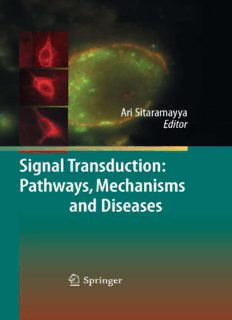
Signal Transduction: Pathways, Mechanisms and Diseases PDF
Preview Signal Transduction: Pathways, Mechanisms and Diseases
Signal Transduction: Pathways, Mechanisms and Diseases Ari Sitaramayya Editor Signal Transduction: Pathways, Mechanisms and Diseases Editor AriSitaramayya ProfessorofBiomedicalSciences 423DHE EyeResearchInstitute OaklandUniversity Rochester,MI48309 USA [email protected] ISBN978-3-642-02111-4 e-ISBN978-3-642-02112-1 DOI10.1007/978-3-642-02112-1 SpringerHeidelbergDordrechtLondonNewYork LibraryofCongressControlNumber:2009928304 #Springer-VerlagBerlinHeidelberg2010 Thisworkissubjecttocopyright.Allrightsarereserved,whetherthewholeorpartofthematerialis concerned,specificallytherightsoftranslation,reprinting,reuseofillustrations,recitation,broadcasting, reproductiononmicrofilmorinanyotherway,andstorageindatabanks.Duplicationofthispublication orpartsthereofispermittedonlyundertheprovisionsoftheGermanCopyrightLawofSeptember9, 1965,initscurrentversion,andpermissionforusemustalwaysbeobtainedfromSpringer.Violationsare liabletoprosecutionundertheGermanCopyrightLaw. Theuseofgeneraldescriptivenames,registerednames,trademarks,etc.inthispublicationdoesnotimply, evenintheabsenceofaspecificstatement,thatsuchnamesareexemptfromtherelevantprotectivelaws andregulationsandthereforefreeforgeneraluse. Coverillustration:CellularandsubcellulardetectionofM2receptorsinstriatalneurons;seeFig.2.1in Chap.2‘‘RegulationofIntraneuronalTraffickingofG-Protein-CoupledReceptorsbyNeurotransmitters InVivo’’byVe´roniqueBernard Coverdesign:WMXDesignGmbH,Heidelberg,Germany Printedonacid-freepaper SpringerispartofSpringerScience+BusinessMedia(www.springer.com) ForUsha,Vani,andAruna Preface Teaching a graduate course on signal transduction in the fall of 2007 was very enjoyable. Each week, my students and I discussed a recently published research paperinsomeareaofsignaling,arguedabouttheappropriatenessofthemethodol- ogy used in the research, the design of the experiments, and whether the conclu- sions drawn were supported by the results presented. Finally, each student was askedtolistwhatwasgoodandwhatwasdeficientinthepaperandwhethershe/he would have accepted or rejected it had she/he reviewed it for publication. For a good number ofrecentpapers, aconsistent complaint ofthe students was that the backgroundtotheresearchwasnotadequatelydescribed.Itcanofcoursebeargued that students should research the background. Either way, the need for a good source of background material in order to appreciate the research presented in a paperbecameapparenttomeandwastheinspirationfordevelopingthisbook. The goal inbringingthis book was toprovide students with a review ofrecent developmentsinspecificareasofcurrentinterestinsignaltransduction,sufficiently indepthtomakerecentresearchpublicationsaccessible. However,giventhewide range of research topics being investigated today in signaling, a choice had to be madetofocusonaselectfew.Thischoicewasmadenotonlykeepingthecurrent research interest in mind, but also with the anticipation that these areas will continuetobeofinterestoverthenextseveralyears. Inchoosingpapersfordiscussioninmyclass,Ilookforhealth-relatednessofthe research,andthatisreflectedinthelistofthebroadareascoveredinthisbook–G protein coupled receptors, growth factors, nuclear receptors, reactive oxygen and nitrogenspecies,cellcycleandcancer;theemphasishasbeenonareasofsignaling researchwithimmediateclinicalsignificance.Ibelievethisbookwillservewellas supplementalreadingmaterialforundergraduateandgraduatestudentswithsimilar interest. Anotherareacoveredinthisbook,onenotoftenhighlightedinsignaltransduc- tionbooks,isthatofsignalingplatforms,whichisemergingasasignificantareaof researchrelevanttocellularmetabolism,cellproliferation,differentiation,apopto- sis, neurodegenerative diseases, and cancer. The authors contributingto this book vii viii Preface are experts and active contributors to research in their specific areas of signaling. I would like to thank them for their contributions and their suggestions in the developmentofthebook.IwouldliketoacknowledgethehelpofFrankTedeschi, astudentinmydepartment,whoassistedineditingthemanuscriptsandinprepar- ingtheindex.IwouldalsoliketothankDr.SabineSchwarz,LifeSciencesEditorat Springer Verlag, and Dr. Jutta Lindenborn who have been very helpful at every stageofproductionofthisbook. AriSitaramayya Contents PartI GProteinsandGProtein–CoupledReceptors 1 TraditionalGPCRPharmacologyandBeyond ............................ 3 AnnetteGilchristandMariaR.Mazzoni 2 RegulationofIntraneuronalTraffickingofG-Protein-Coupled ReceptorsbyNeurotransmittersInVivo ................................. 25 Ve´roniqueBernard 3 SmallGTPasesandTheirRoleinRegulatingGProtein-Coupled ReceptorSignalTransduction ............................................. 43 FabiolaM.RibeiroandStephenS.G.Ferguson 4 RegulationofGProteinReceptorCoupling,MoodDisorders andMechanismofActionofAntidepressants ............................ 63 MoranGolan,GabrielSchreiber,andSofiaAvissar 5 DysregulationofGProtein-CoupledReceptorSignaling inCancer .................................................................... 83 JoAnnTrejo PartII GrowthFactors 6 InsulinSignalinginNormalandDiabeticConditions ................. 101 PatriceEFort,HisanoriImai,RajuRajala,andThomasW.Gardner 7 EpidermalGrowthFactor(EGF)ReceptorSignaling andCancer ................................................................ 119 ElizabethS.HensonandSpencerB.Gibson ix x Contents 8 LeptinSignalingPathway ............................................... 143 HiroyukiShimizu 9 SignalinginNormalandPathologicalAngiogenesis .................. 159 MichaelR.MancusoandCalvinJ.Kuo PartIII SignalingPlatforms 10 SpatialandTemporalControlofCellSignaling byA-KinaseAnchoringProteins ....................................... 183 F.DonelsonSmith,LoreneK.Langeberg,andJohnD.Scott 11 Mitochondria,aPlatformforDiverseSignalingPathways .......... 199 AstridC.SchaussandHeidiM.McBridee 12 Mitogen-ActivatedProteinKinases andTheirScaffoldingProteins ......................................... 219 DannyN.DhanasekaranandE.PremkumarReddy 13 MolecularandFunctionalDeterminantsofCa2þ SignalingMicrodomains ................................................ 237 InduS.Ambudkar,HweiL.Ong,andBrijB.Singh PartIV NuclearReceptors/Transcription 14 EukaryoticGeneTranscription ........................................ 257 JenniferH.GromekandArikDvir 15 EstrogenSignalingMechanisms ........................................ 273 DapengZhangandVanceL.Trudeau 16 SignalTransductionPathwaysInvolved inGlucocorticoidActions ............................................... 289 PeterJ.Barnes PartV ReactiveSignalingMolecules 17 CellularSignalingbyReactiveOxygenSpecies:Biochemical BasisandPhysiologicalScope .......................................... 313 MichelB.Toledano,SimonFourquet,andBenoˆıtD’Autre´aux 18 SolubleGuanylylCyclase:TheNitricOxideReceptor ............... 337 DorisKoeslingandAriSitaramayya Contents xi PartVI CellCycle,CellDeathandCancer 19 DistinctRolesofthePocketProteinsintheControl ofCellCycle .............................................................. 353 ParaskeviVogiatziandPierPaoloClaudio 20 Activationofthep53TumorSuppressoranditsMultipleRoles inCellCycleandApoptosis ............................................. 375 LucianaE.GionoandJamesJ.Manfredi 21 AgingandCancer:CaretakersandGatekeepers ..................... 397 DianavanHeemst 22 SignalTransductioninEmbryonicStemCells andtheRiseofiPSCells ................................................ 417 SoleneJamet,RuairiFriel,andP.JosephMee Index ......................................................................... 427
Description: